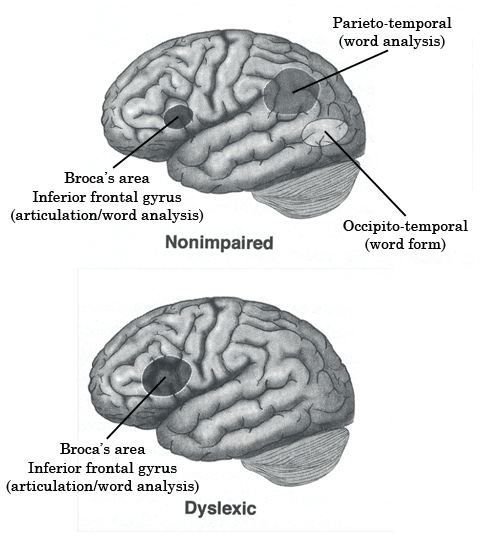Neurologically Speaking: Dyslexia and the Brain's Language Processing Centers
Everyone has experienced times when they did not perform to the best of their abilities signifying a glitch in the information processing centers of the brain. With these temporary dysfunctions, the average person will grow and acquire knowledge on a predictable continuum as they develop, but this is not the case for someone who continually has problems with simple, language related tasks. For someone with dyslexia, the brain’s ability to process information has been compromised consistently and pervasively enough to cause a lifelong problem.
Effects of Dyslexia
Dyslexia is a condition where the brain, due to slow development, is physically different from someone who is not affected by the disorder causing impairment in the processing and memorization of words through expressive and receptive language regardless of native language. Although the student may be highly intelligent they commonly struggle in areas that it may seem they should excel in, but because of neurological problems, they usually perform poorly academically. Not only are reading and spelling impaired, both due to deficits in phonemic awareness and phonological processing, but handwriting is affected as well.
Some students with dyslexia may deal with letter reversals, but they all struggle with decoding words and sight reading, making word recognition a constant issue essentially – slowing down reading. The root of this problem is caused by a specific deficiency with phonological components of language, which connects sounds to letters.
Areas of the Brain Affected
Six areas of the left hemisphere of the brain are at the forefront of the discussion of the causes of dyslexia.
The **frontal lobe**, located behind the forehead, does the job of controlling speech, consciousness, reasoning, emotions, affects the ability to sight read, and contains Broca's area. This section of the brain is where language is essentially stored, organized, and controlled.
-
Neurological problems in the parietal lobe are the reason for many of the issues of memory tied to reading, particularly comprehension. This area of the brain also links written and spoken language to each other, which are very necessary for fluent reading. The parietal lobe also controls sensory perception and is located behind the frontal lobe.
-
The left parietotemporal system is the exact part of the brain found to impact the ability of a person to decode words. What happens in this system is letters are attached to sounds but when there is a neurological disorder preventing normal processing, then there will be problems deciphering words, recalling letter sounds, and comprehending written text without interventions to do so.
-
The specific problem dyslexics have with letter identification can be traced back to physical differences in the occipital lobe. It holds the visual cortex and manages several visual perceptions.
-
Verbal problems are associated with physical differences in the temporal lobe. When a person has problems recalling spoken details, deficits in this area are the cause.
-
Occipitotemporal area helps a person to quickly recall words with a mechanical agility, but when this area is physically different from the average reader, reading will be significantly slowed down because of it.
How the Brain of a Person With Dyslexia Differs From the Nonimpaired
A dyslexic brain as a whole is different from that of someone who does not have the disorder based on the amount of gray (the mass of nerve cells visible when you look at the brain) and white matter (wiring as part of a system that maintains communication between nerve cells) present in the brain.
A person without dyslexia will have not enough gray matter in their parietotemporal area hindering the processing of the sounds behind language. At the same time there is a shortage of white matter in this area making it difficult for other parts of the brain to “get on board” with each other and work as a total unit for language processing.
Fluent Reading Is Possible
The roots of the characteristics displayed in someone with dyslexia are concrete and have been well researched fundamentally voiding any stigmas and inflated misconceptions of the disorder. Slower reading may be a lifelong issue for a person with dyslexia but fluent reading is possible. Brain rewiring should be the ever-present goal when trying to improve reading impaired by dyslexia.
With specific information on which parts of the brain that are afflicted, teachers, parents, and the person with dyslexia themselves, should have a better time of addressing their problems and should know that their physical brain differences can be improved with well-developed and specific interventions that target the areas they need help in the most.
References
- Image, www.ReadingHorizons.com
This post is part of the series: How the Brain Works
Informational articles about brain and how it relates to special education arenas.
